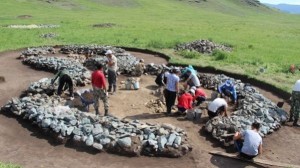EAST KAZAKHSTAN REGION – Unique archaeological findings of the early nomads epoch discovered in recent years in the Altai mountains have substantially raised the prestige of the archaeologist’s profession in the eyes of East Kazakh students.
 This summer, 14 Amanzholov East Kazakhstan State University (EKSU) students participated in an archaeological expedition led by well-known scientist and doctor of historical sciences Zeinolla Samashev. Among those students was Sayat Shayakhmetov, who is studying to be an interpreter and who had been on two previous expeditions, as well as law students.
This summer, 14 Amanzholov East Kazakhstan State University (EKSU) students participated in an archaeological expedition led by well-known scientist and doctor of historical sciences Zeinolla Samashev. Among those students was Sayat Shayakhmetov, who is studying to be an interpreter and who had been on two previous expeditions, as well as law students.
Many of the students say their decision to pursue archeology came after hearing Kazakh President Nursultan Nazarbayev in an interview with the Khabar TV in the foothills of Ulytau mountains in late August.
“Last year, one of the mounds near Berel village brought archaeologists some sensational discoveries,” said Dastan Musaipov, a history student. “It was possible to detect artifacts that shed light on some issues of culturogenesis, the epoch of early nomads. For example, two musical instruments, similar to kobyz, were found, that until recently were not a characteristic for burials in the Valley of the Saka kings.”
According to Musaipov, they managed to find a lot of interesting pieces of jewelry in the famous Scythian-Siberian style. The archaeologists’ findings seemed to indicate that the ancient masters never made two identical things.
Last summer, at the excavation in Berel, and in the current archaeological season, which took place at the junction of the Altai and Tarbagatai mountains along the Kara-Kaba River, the burials of noble warriors were found, which are similar in the presence of the skull trepanation of a perfectly rounded shape with a diameter of four and six centimetres. The presence of the crust that covered the hole, according to experts, suggests that people lived a long time with it. One of the hypotheses is that the trepanation was made not for medical but for religious purposes. For example, they may have been made for ancient religious rites that always involved communication with Tengri – a bright deity personifying the sky for Turks.
According to Samashev, the musical instrument found this summer that was like the two that had been discovered in the past two archaeological seasons is a major finding.
Meanwhile, on the other side of the Altai, on the neighbouring Russian territory, a flute and even a lute were found while a musical instrument was found in the cemetery of Kara-Kaba that is similar to the Uzbek dutar. A full description will come after a scientific examination.
One can understand the delight of the students who carefully cleared all these valuable finds by means of special brushes. At such moments, several days of routine preparatory work are forgotten.
“We had to wrap each found fragment with tissue paper and to moisturise it several times a day. Without these mandatory manipulations, the artifacts in a few hours would have dried up and turned into dust,” said senior high school teacher Kuralai Zhirendinova.
However, according to the students, the most difficult thing was to carry out a recess. It is necessary to be very cautious and careful in the process of extracting findings from the mounds. Together with the dirt, the artifact is carefully wrapped up in a multi-layer package of foam and sponge, and only then is it placed in a separate box.
In the burial at Kara-Kaba, archaeologists found a complete set of military paraphernalia – a wooden bow with bony plates, a helmet, a large quiver, an arrow, a sword, a whip, and even horse harness. The iron sword placed in a birch bark cover deserves separate mentioning.
The latter, according to archaeologists, was discovered there for the first time. Although the sword belonging to the period of Kimak Khanate is not that rare a find. The fact that it was stored in a birch bark cover is a revelation in itself. And, last summer, archaeologists unearthed a sword, the hilt of which was covered by ray skin.
Another burial belonging to a bone carver was also found on the territory of Kazakhstan for the first time recently. The site yielded animal horns, hammer-like tools and a pickaxe.
“Almost all of the finds are very well preserved. It is not surprising because the ancient inhabitants many centuries ago occupying the territory of the East Kazakhstan region possessed unique skills in construction, and in burials for two millennia the effect of permafrost was sustained,” Shayakhmetov said.


